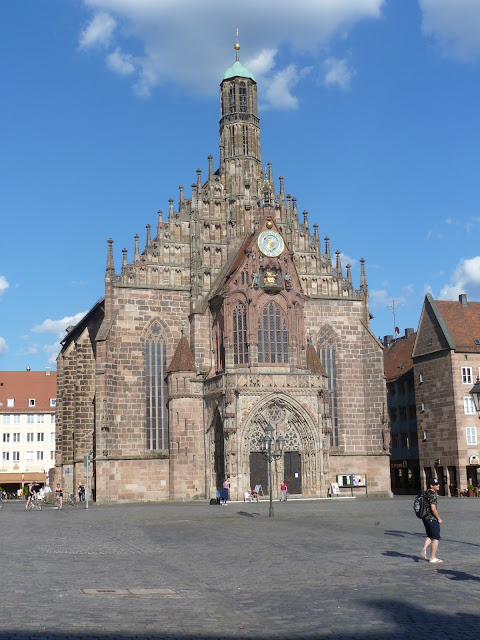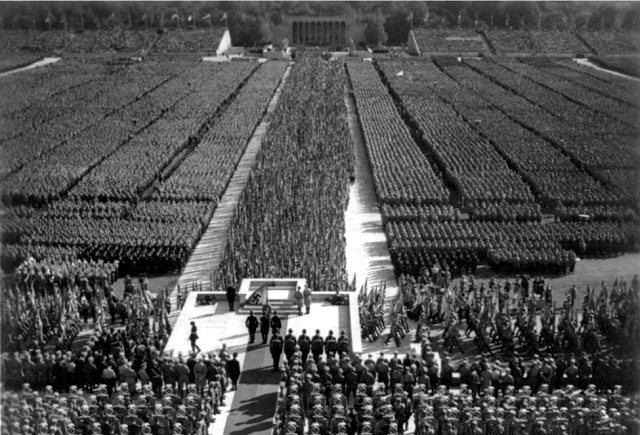Nuremberg is one of my favorite cities in Germany, a city with a rich -- and a dark -- past.
Most of these are my pictures and are freely available. Others are historical photos.
The spires of Sankt Sebaldus and the Castle.
The spires of Sankt Lorenz from a busy street.
The old medieval city walls still survive largely intact around the city center.
The Heilig Geist Spital, the Hospital of the Holy Spirit spans the Pegnitz river.
The choir of Sankt Sebaldus and the old Rathaus from the Hauptmarkt.
The same view in 1934. Photo from Wikipedia
The Judensau, a very offensive antisemitic medieval image of two Jews suckling on a sow; a 14th century carving on a console that once supported a now lost statue; on the exterior of the choir of Sankt Sebaldus.
The Hauptmarkt, the main market square of Nuremberg with the Frauenkirche in the background. The square was very busy setting up for a summer folk festival with a lot of outdoor eating and drinking.
The Hauptmarkt in 1934; photo from Getty Images.
The Nazis used the Hauptmarkt for military reviews during the annual party rallies.
The Frauenkirche, a Roman Catholic church since the early 19th century. Like all of Nuremberg's churches, it went Lutheran when the city council voted to become Protestant in 1525. When Napoleon made the region of Franconia part of Bavaria, the King of Bavaria made the church Catholic.
The Holy Roman Emperor Charles IV had the church built in the 14th century to designs by the Parler dynasty of architects and stonemasons.
The church has a very dark history. It stands on the site of Nuremberg's medieval synagogue destroyed in a pogrom in 1349, probably brought on by the Black Death. The Hauptmarkt was once the city's Jewish quarter, likewise destroyed by the pogrom.
Interior of the Frauenkirche
A Star of David memorializes the old synagogue in the chancel. The star bears the date, 1349.
The very controversial 20th century martyr saint Edith Stein has a statue in the church with a Star of David on the console.
A decaying 14th century fresco.
A great gruesome memento mori in the Frauenkirche.
The Goose Man Fountain outside the Rathaus dating from 1550. It was originally located in the fruit market behind the Frauenkirche and moved here after World War II.
The building near the train station that once housed the Deutscherhof Hotel.
The Luitpoldhain, the "Grove of Prince Regent Luitpold of Bavaria," a city park since 1906.
The same view as the photo above this one in 1934. Hitler turned the Luitpold park into the Luitpold arena; a parade ground for SA and the SS troops and the largest of the parade grounds in Nuremberg. The arena was destroyed and the park restored soon after World War II ended. Photo from here.
This same view in 1934, a still from Triumph of the Will, photo from here.
The Ehrenhalle, the only part of the Luitpoldarena that survives. It is a First World War memorial completed in 1929 and appropriated by the Nazis.
When I was there, they were putting up a stage for a folk festival concert in front of it.
American soldiers on Hitler's rostrum at the Luitpoldarena in 1945. Photo from Corbis.
The site of the rostrum today.
The steps that are all that remain of the Luitpoldhalle are now a beautiful flower garden.
The Luitpoldhalle in the 1930s; the Nazis used an old industrial exhibition hall for annual party congresses. They modified the original building considerably. Allied bombs destroyed it in 1945. Photo from here.
The Luitpoldhalle interior in 1934, a still from Triumph of the Will; photo from here.
The bleak expanse of the Reichsparteitagsgelände today.
The immense remains of the unfinished Kongresshalle; the huge ruin now contains the Documentation Center, a really fine museum about the parade grounds with a great presentation on Nazi propaganda and how it was used. I learned there that the annual Nazi rallies in Nuremberg were the first political events to be televised live. The Nazis set up television screens in public viewing areas in cities and especially rural villages. The museum even had some surprisingly clear videotape with many unscripted moments that never made it into the official films.
The Grossestrasse paved with granite quarried by forced prisoner labor from the Flossenburg Concentration Camp.
The old fishponds near the parade grounds where Dürer once painted watercolors like the one below.
Reproduction from Wikiart.
The exit from a folk festival on the old parade grounds. At last, a structure on the parade grounds I can endorse.
For the truly homesick ...






































No comments:
Post a Comment